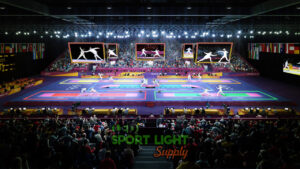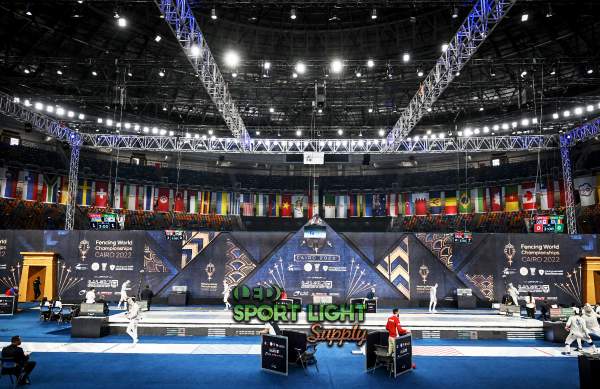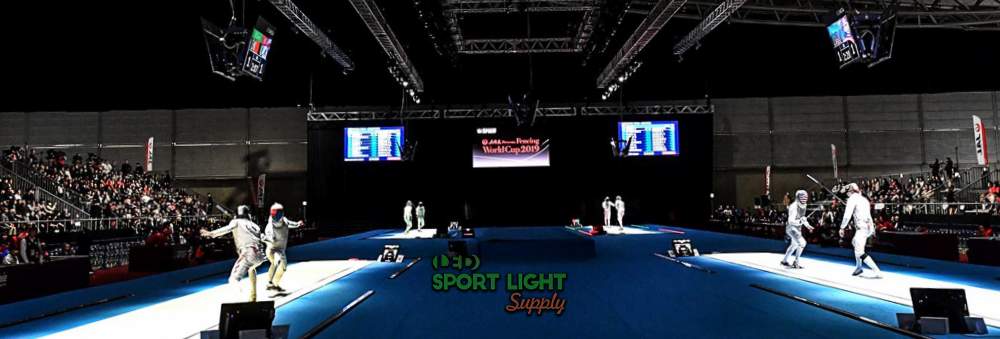
The quality of lighting can significantly impact visibility, comfort, and the overall experience within the venue. In recent years, LED lighting has emerged as a preferred choice for sports facilities due to its energy efficiency, longevity, and superior performance. For fencing halls, where precision and focus are crucial, using the right lighting technology is key to ensuring that events run smoothly and fairly.
Table of Contents
Toggle LED lighting offers several advantages compared to traditional incandescent or fluorescent bulbs. These modern lighting systems consume significantly less energy while delivering high levels of brightness, which can lead to considerable cost savings over time. By reducing electricity consumption, fencing halls can benefit from lower operational expenses without compromising on illumination quality.
LED lighting offers several advantages compared to traditional incandescent or fluorescent bulbs. These modern lighting systems consume significantly less energy while delivering high levels of brightness, which can lead to considerable cost savings over time. By reducing electricity consumption, fencing halls can benefit from lower operational expenses without compromising on illumination quality.
The energy efficiency of LED lights also translates to reduced heat output. Traditional light sources, especially incandescent bulbs, emit a large amount of heat, which can contribute to uncomfortable conditions in indoor settings. In contrast, LEDs operate at a much cooler temperature, helping to maintain a pleasant atmosphere for athletes, officials, and spectators. This aspect is particularly beneficial in a fencing hall, where excessive heat can affect athletes’ performance and the comfort of the audience.
LED lights can be strategically installed to maximize illumination while minimizing power consumption. Fencing halls often require specific lighting arrangements to achieve the necessary brightness levels across the entire playing area. By using LEDs, it is possible to position lights in a way that targets specific zones, such as the fencing strips, while reducing the need for multiple fixtures. This ensures that the entire venue is well-lit without excessive energy usage.
| Area | Recommended Lux Level (lx) | Uniformity Ratio | Color Temperature (Kelvin) |
|---|---|---|---|
| Fencing Strips | 500 – 750 | ≥ 0.7 | 4000K – 5000K |
| Spectator Seating | 300 – 500 | ≥ 0.6 | 4000K – 5000K |
| Warm-up Areas | 300 – 400 | ≥ 0.6 | 3500K – 4500K |
| Officials’ Table | 500 – 700 | ≥ 0.7 | 4000K – 5000K |
| Hallways & Entrances | 150 – 250 | ≥ 0.5 | 3500K – 4500K |
| Changing Rooms | 200 – 300 | ≥ 0.6 | 3500K – 4500K |
One of the standout features of LED technology is its ability to reduce glare, which is a crucial factor in sports like fencing where athletes rely on sharp visual focus. Traditional lighting systems can produce harsh reflections, making it difficult for fencers to see their opponents clearly. By contrast, LEDs can be equipped with diffusers and reflectors that control the direction of light, significantly reducing glare.
In a fencing match, any visual distractions can impact an athlete’s reaction time and precision. By opting for LEDs with anti-glare technology, venue operators can create a more conducive environment for competitive play. This not only enhances the experience for athletes but also ensures that referees and judges have a clear view of the action, leading to more accurate adjudication.
Uniform lighting is essential for maintaining consistent visibility throughout a fencing hall. LEDs excel in providing even illumination, ensuring that there are no dark spots or overly bright areas on the fencing strips. This uniformity is critical for athletes to gauge distances and movements accurately. Diffusers and custom reflectors can be used to spread the light evenly, covering the entire playing area and eliminating shadows that could interfere with performance.
To achieve the best results, LED fixtures can be designed with specific beam angles that suit the layout of the venue. This level of customization allows for precise control over light distribution, enhancing both the functional and aesthetic aspects of the fencing hall.
One of the most significant advantages of LED lighting is its durability. LED fixtures are designed to last much longer than traditional bulbs, which means fewer replacements and reduced maintenance costs. For fencing halls, where lighting systems are often in use for extended periods, this is particularly beneficial. A longer lifespan translates into fewer disruptions during events, ensuring that competitions can proceed without unexpected lighting failures.
Traditional bulbs, such as incandescents or fluorescents, are prone to burnout and require frequent replacement, especially when used in high-demand environments like sports facilities. In contrast, LEDs have a lifespan that can extend up to 50,000 hours or more, making them a cost-effective choice for long-term operation. This longevity not only reduces operational costs but also minimizes the environmental impact by reducing waste.
Fencing competitions often require continuous lighting over several hours, which can strain older lighting systems. LEDs are highly reliable under such conditions, offering consistent performance without dimming or overheating. This reliability is crucial for maintaining optimal conditions throughout tournaments, where the integrity of the lighting system directly affects the quality of the event.

The level of illumination in a fencing hall is measured in lux, which indicates the intensity of light on a given surface area. For competitive fencing, experts recommend a minimum illumination level of 500 lux to ensure that both athletes and officials have clear visibility. Proper lighting levels are not only vital for the performance of the athletes but also for the accuracy of referees in making split-second decisions.
Illumination levels can vary based on the specific needs of the venue. For training facilities, slightly lower lux levels may be acceptable, while official competitions may require higher brightness to meet regulatory standards. LED lighting systems can be adjusted to achieve these precise lux levels, making them a versatile solution for different fencing environments.
Achieving consistent illumination levels across all areas of the fencing hall is essential. LEDs can be adjusted to ensure that the light is distributed evenly, from the fencing strips to the spectator seating areas. This uniformity helps in maintaining a high standard of visibility throughout the venue, ensuring that every angle is well-lit for both athletes and audiences.
Proper light distribution is crucial to avoid shadows that can interfere with athletes’ focus and movement. LEDs offer flexibility in installation, allowing for various configurations to optimize light coverage. Common practices include mounting lights along the perimeter and overhead, which provides balanced illumination across the fencing area.
Adjustable fixtures can be used to modify the direction and intensity of light, catering to the specific needs of different events. For instance, by angling the lights strategically, operators can minimize glare while ensuring that every corner of the hall is adequately illuminated. This flexibility in light placement enhances the versatility of the fencing hall, allowing it to accommodate various types of competitions and training sessions.
The use of adjustable and dimmable LED fixtures adds another layer of customization. For events where lighting needs may vary, such as exhibitions or mixed-use venues, having the ability to fine-tune the lighting setup can be highly beneficial. This adaptability ensures that the fencing hall can remain functional and effective, regardless of the nature of the event being hosted.
The color temperature of lighting influences not only the ambiance of a space but also its functionality. For fencing halls, a color temperature in the range of 4000K to 5000K is ideal, as it closely resembles natural daylight. This neutral white light enhances visibility without altering the perception of colors, which is crucial for both athletes and referees.
Lighting that is too warm (below 3000K) can create a yellowish tint, which may reduce visibility, while overly cool lighting (above 6000K) can feel harsh and uncomfortable. By selecting LEDs within the recommended color temperature range, fencing halls can create a visually comfortable environment that supports peak athletic performance.
Fencing halls must comply with specific lighting standards set by organizations such as the International Fencing Federation (FIE). These standards outline the required illumination levels, light distribution, and fixture placement to ensure fair and safe competition conditions. Compliance with these guidelines not only upholds the integrity of the sport but also ensures the safety of athletes and officials.
Lighting designers should work closely with regulatory bodies to ensure that the installed systems meet all required standards. This collaboration helps to achieve the optimal lighting setup while also future-proofing the venue for upcoming events and inspections.
Integrating LED lighting into the overall design of a fencing hall enhances both its functionality and aesthetic appeal. By selecting fixtures that complement the venue’s architecture, it is possible to create a cohesive environment that supports the needs of athletes and spectators alike. Thoughtful lighting design can highlight key areas, such as the fencing strips and seating sections, ensuring that each part of the venue is adequately illuminated.
Collaboration with architects and lighting engineers can lead to a more seamless integration of lighting systems. This not only improves the visual impact of the fencing hall but also ensures that the lighting enhances the overall experience for all participants.
LED lighting systems offer a range of advantages that make them a compelling choice for fencing halls. From energy efficiency and reduced maintenance to superior light quality and customization options, LEDs provide solutions that enhance the functionality of these specialized venues. By focusing on strategic placement, optimal color temperatures, and compliance with industry standards, fencing halls can create an environment that supports both the athletes’ performance and the enjoyment of spectators.
Drop us a line to receive a free lighting design